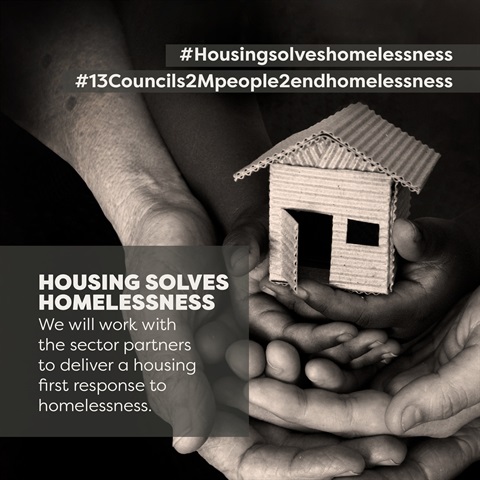Councils unite to address homelessness in the suburbs
Published on 02 August 2021

The number of homeless men, women and children is growing in suburban areas and COVID-19 has further impacted the vulnerability of those who sleep rough without a safe place to call home.
Monash is among 13 eastern and south eastern municipalities uniting to address homelessness with a best practice guide launched during Homelessness Week, the Housing First for People Sleeping Rough Practice Guide for Local Government.
More than 116,000 Australians and almost 25,000 Victorians were homeless on any given night pre-COVID-19 (ABS 2016 Census*), including 7,490 across the 13 municipalities and 755 in Monash. Council staff have since noticed more people experiencing homelessness in the suburbs.
The 13 eastern and south eastern Council CEOs formed the Regional Local Government Homelessness and Social Housing Charter Group in late 2019 to end homelessness and advocate for more social housing. The 2016 Census found 32 per cent of Victorians without a home lived in this region.
Led by Monash CEO Dr Andi Diamond and endorsed by all 13 CEOs, the Charter Group Councils recognise the growing need for suburban and local government advocacy for our most vulnerable through improved supports and more permanent and safe housing.
The municipalities include Bayside Council, the City of Casey, City of Cardinia, Frankston City Council, City of Greater Dandenong, Knox City Council, City of Kingston, Manningham City Council, City of Monash, Maroondah City Council, Mornington Peninsula Shire, City of Whitehorse, and Yarra Ranges Council.
Housing First for People Sleeping Rough Practice Guide for Local Government acknowledges that homelessness is a complex issue requiring a triage of support including mental health, but the first step needs to be providing a safe and secure home. The Councils’ mayors have also offered their support.
The guide outlines the problem and possible solutions based on current best practice. It draws on evidence-based research about the value of social housing across the local government sector and communities, with an emphasis on the ‘Housing First’ model.
Housing First is based on consumer choice, harm minimisation, human rights and collaboration. It relies on adequate housing supply and coordinated support services. Any Council can use the guide to reflect, better understand the Housing First model and see how others approach the issue.
Dr Diamond said the Councils sought systemic change to improve supply of permanent, safe, appropriate and timely housing for those who needed it, and to embed Housing First as a key foundation principle.
She said the collaboration enabled benchmarking, shared ideas and the development of best practice protocols, resources, sector networks, community education and advocacy for more social housing. It also welcomed the recent $5.3 billion Victorian Government investment in social housing.
“Homelessness is a growing problem in our suburbs, and COVID has complicated the situation,” Dr Diamond said. “Local councils are closest to the communities they serve. As providers of ground-level services, councils are well placed to make a difference.
“Collectively, councils can share experiences and join forces to address the situation more effectively and efficiently. Everyone has a right to safe housing and we all have a responsibility to make it happen.”
The guide encourages a whole of Council approach to homelessness based on human rights, including everyone’s right to a safe and affordable home, while protecting public places and spaces.
The City of Monash’s Homelessness Protocol is featured. For four years, Council has employed a senior officer dedicated to providing assertive social outreach to residents experiencing homelessness.
Under the frameworks of social justice, human rights and community development, the officer works intensively with individuals and families to build the trust of residents experiencing homelessness, and to work towards identified goals.
The officer also works across Council to build the capacity of relevant staff to apply the Council protocol, which guides Council staff in responding to homelessness.
In a demonstration of its continued commitment to housing our most vulnerable, this year Monash Council also identified three Council-owned areas of land that could be considered for social housing development. This is in direct response to the State Government’s $5.3 billion Big Housing Build.
The three sites are 1399 – 1401 Centre Road, Clayton, 329 – 333 Waverley Road, Mount Waverley, and 65a Power Avenue Chadstone. Council hopes to partner with registered housing associations to develop these plans and will seek community input during this process.
The new guide follows initial research that the City of Monash commissioned through the Council to Homeless Persons: Making a difference – effective local government responses to homelessness.
It found Councils were well placed to address homelessness as by-laws officers, parks staff or contractors often interacted with people sleeping rough on public land and facilities.
Often out of concern, local businesses and residents are also likely to contact Councils’ customer service staff to report people experiencing homelessness.
The resulting Regional Local Government Homelessness and Social Housing Charter (Charter) was endorsed by the 13 Charter Group councils, the Eastern Region Group of Councils and Eastern Affordable Housing Alliance.
*The 2016 Census provides important indicative data for comparison between regions and across time, but does not capture every resident living in every situation, particularly those sleeping rough in locations where they may not be visible to Census takers. New data will be collected in the 2021 Census.